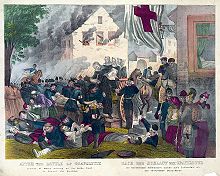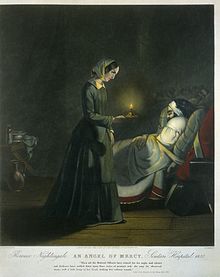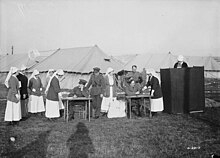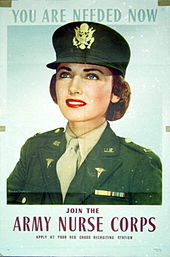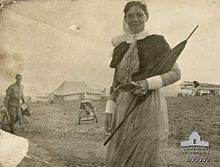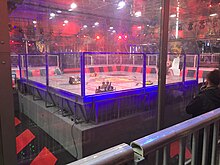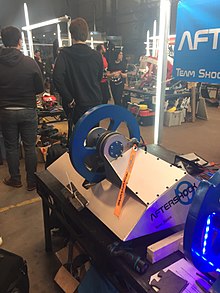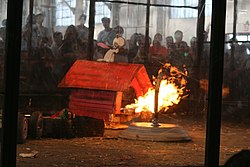From the earliest times most cultures produced a stream of nurses dedicated to service on religious principles. Both Christendom and the Muslim World generated a stream of dedicated nurses from their earliest days. In Europe before the foundation of modern nursing, Catholic nuns and the military often provided nursing-like services. It took until the 19th century for nursing to become a secular profession.
Ancient history
The early history of nurses suffers from a lack of source material, but nursing in general has long been an extension of the wet-nurse function of women.
Buddhist Indian ruler (268 B.C.E. to 232 B.C.E.) Ashoka erected a series of pillars,
which included an edict ordering hospitals to be built along the routes
of travelers, and that they be "well provided with instruments and
medicine, consisting of mineral and vegetable drugs, with roots and
fruits"; "Whenever there is no provision of drugs, medical roots, and
herbs, they are to be supplied, and skilful physicians appointed at the
expense of the state to administer them." The system of public hospitals
continued until the fall of Buddhism in India ca. 750 CE.
About 100 B.C.E. the Charaka Samhita
was written in India, stating that good medical practice requires a
patient, physician, nurse, and medicines, with the nurse required to be
knowledgeable, skilled at preparing formulations and dosage, sympathetic
towards everyone, and clean.
The first known Christian nurse, Phoebe, is mentioned in Romans 16:1. During the early years of the Christian Church (ca. 50 C.E.), St. Paul sent a deaconess named Phoebe to Rome as the first visiting nurse.
From its earliest days, following the edicts of Jesus, Christianity encouraged its devotees to tend the sick. Priests were often also physicians. According to the historian Geoffrey Blainey,
while pagan religions seldom offered help to the infirm, the early
Christians were willing to nurse the sick and take food to them, notably
during the smallpox epidemic of AD 165-180 and the measles outbreak of
around AD 250; "In nursing the sick and dying, regardless of religion,
the Christians won friends and sympathisers".
Following the First Council of Nicaea
in 325 AD, Christianity became the official religion of the Roman
Empire, leading to an expansion of the provision of care. Among the
earliest were those built ca. 370 by St. Basil the Great, bishop of Caesarea Mazaca in Cappadocia in Asia Minor (modern-day Turkey), by Saint Fabiola in Rome ca. 390, and by the physician-priest Saint Sampson (d. 530) in Constantinople,
Called the Basiliad, St. Basil's hospital resembled a city, and
included housing for doctors and nurses and separate buildings for
various classes of patients. There was a separate section for lepers. Eventually construction of a hospital in every cathedral town was begun.
Christian emphasis on practical charity gave rise to the
development of systematic nursing and hospitals after the end of the
persecution of the early church. Ancient church leaders like St. Benedict of Nursia (480-547) emphasized medicine as an aid to the provision of hospitality. 12th century Roman Catholic orders like the Dominicans and Carmelites have long lived in religious communities that work for the care of the sick.
Some hospitals maintained libraries and training programs, and
doctors compiled their medical and pharmacological studies in
manuscripts. Thus in-patient medical care in the sense of what we today
consider a hospital, was an invention driven by Christian mercy and
Byzantine innovation. Byzantine hospital staff included the Chief Physician
(archiatroi), professional nurses (hypourgoi) and orderlies
(hyperetai). By the twelfth century, Constantinople had two
well-organized hospitals, staffed by doctors who were both male and
female. Facilities included systematic treatment procedures and
specialized wards for various diseases.
In the early 7th century, Rufaidah bint Sa’ad (also known as Rufaida Al-Aslamia) became what is now described as the first Muslim nurse.
A contemporary of Muhammad, she hailed from the Bani Aslam tribe in
Medina and learned her medical skills from her father, a traditional
healer. After she had led a group of women to treat injured fighters on
the battlefield, Muhammad gave her permission to set up a tent near the
Medina mosque to provide treatment and care for the ill and the needy.
Medieval Europe
Medieval hospitals in Europe followed a similar pattern to the Byzantine. They were religious communities, with care provided by monks and nuns. (An old French term for hospital is hôtel-Dieu,
"hostel of God.") Some were attached to monasteries; others were
independent and had their own endowments, usually of property, which
provided income for their support. Some hospitals were multi-functional
while others were founded for specific purposes such as leper hospitals,
or as refuges for the poor, or for pilgrims: not all cared for the sick. The first Spanish hospital, founded by the Catholic Visigoth bishop Masona in 580AD at Mérida, was a xenodochium designed as an inn for travellers (mostly pilgrims to the shrine of Eulalia of Mérida)
as well as a hospital for citizens and local farmers. The hospital's
endowment consisted of farms to feed its patients and guests. From the
account given by Paul the Deacon we learn that this hospital was
supplied with physicians and nurses, whose mission included the care the
sick wherever they were found, "slave or free, Christian or Jew."
During the late 700s and early 800s, Emperor Charlemagne decreed
that those hospitals which had been well conducted before his time and
had fallen into decay should be restored in accordance with the needs of
the time. He further ordered that a hospital should be attached to each cathedral and monastery.
During the tenth century the monasteries became a dominant factor
in hospital work. The famous Benedictine Abbey of Cluny, founded in
910, set the example which was widely imitated throughout France and
Germany. Besides its infirmary for the religious, each monastery had a
hospital in which externs were cared for. These were in charge of the eleemosynarius, whose duties, carefully prescribed by the rule, included every sort of service that the visitor or patient could require.
As the eleemosynarius was obliged to seek out the sick and needy
in the neighborhood, each monastery became a center for the relief of
suffering. Among the monasteries notable in this respect were those of
the Benedictines at Corbie in Picardy, Hirschau, Braunweiler, Deutz,
Ilsenburg, Liesborn, Pram, and Fulda; those of the Cistercians at
Arnsberg, Baumgarten, Eberbach, Himmenrode, Herrnalb, Volkenrode, and
Walkenried.
No less efficient was the work done by the diocesan clergy in
accordance with the disciplinary enactments of the councils of Aachen
(817, 836), which prescribed that a hospital should be maintained in
connection with each collegiate church. The canons were obliged to
contribute towards the support of the hospital, and one of their number
had charge of the inmates. As these hospitals were located in cities,
more numerous demands were made upon them than upon those attached to
the monasteries. In this movement the bishop naturally took the lead,
hence the hospitals founded by Heribert (died 1021) in Cologne, Godard
(died 1038) in Hildesheim, Conrad (died 975) in Constance, and Ulrich
(died 973) in Augsburg. But similar provision was made by the other
churches; thus at Trier the hospitals of St. Maximin, St. Matthew, St.
Simeon, and St. James took their names from the churches to which they
were attached. During the period 1207–1577 no less than 155 hospitals
were founded in Germany.
The Ospedale Maggiore, traditionally named Ca' Granda (i.e. Big House), in Milan,
northern Italy, was constructed to house one of the first community
hospitals, the largest such undertaking of the fifteenth century.
Commissioned by Francesco Sforza in 1456 and designed by Antonio
Filarete it is among the first examples of Renaissance architecture in
Lombardy.
The Normans brought their hospital system along when they
conquered England in 1066. By merging with traditional land-tenure and
customs, the new charitable houses became popular and were distinct from
both English monasteries and French hospitals. They dispensed alms and
some medicine, and were generously endowed by the nobility and gentry
who counted on them for spiritual rewards after death.
According to Geoffrey Blainey, the Catholic Church in Europe
provided many of the services of a welfare state: "It conducted
hospitals for the old and orphanages for the young; hospices for the
sick of all ages; places for the lepers; and hostels or inns where
pilgrims could buy a cheap bed and meal". It supplied food to the
population during famine and distributed food to the poor. This welfare
system the church funded through collecting taxes on a large scale and
possessing large farmlands and estates.
Roles for women
Catholic women played large roles in health and healing in medieval and early modern Europe.
A life as a nun was a prestigious role; wealthy families provided
dowries for their daughters, and these funded the convents, while the
nuns provided free nursing care for the poor.
Meanwhile, in Catholic lands such as France, rich families
continued to fund convents and monasteries, and enrolled their daughters
as nuns who provided free health services to the poor. Nursing was a
religious role for the nurse, and there was little call for science.
Middle East
The Eastern Orthodox Church had established many hospitals in the middle east, but following the rise of Islam from the 7th century, Arabic medicine developed in this region, where a number of important advances were made and an Islamic tradition of nursing begun. Arab ideas were later influential in Europe. The famous Knights Hospitaller
arose as a group of individuals associated with an Amalfitan hospital
in Jerusalem, which was built to provide care for poor, sick or injured
Christian pilgrims to the Holy Land. Following the capture of the city
by Crusaders, the order became a military as well as infirmarian order.
Roman Catholic orders such as the Franciscans stressed tending the sick, especially during the devastating plagues.
Early modern Europe
"After the Battle of Gravelotte.
The French Sisters of Mercy of St. Borromeo arriving on the battle
field to succor the wounded." Unsigned lithograph, 1870 or 1871.
Catholic Europe
The Catholic elites provided hospital services because of their
theology of salvation that good works were the route to heaven. The same
theology holds strong into the 21st century. In Catholic areas, the
tradition of nursing sisters continued uninterrupted. Several orders of
nuns provided nursing services in hospitals. A leadership role was taken by the Daughters of Charity of Saint Vincent de Paul, founded in France in 1633. New orders of Catholic nuns expanded the range of activities and reached new areas. For example, in rural Brittany in France, the Daughters of the Holy Spirit,
created in 1706, played a central role. New opportunity for nuns as
charitable practitioners were created by devout nobles on their own
estates. The nuns provided comprehensive care for the sick poor on their
patrons' estates, acting not only as nurses, but took on expanded roles
as physicians, surgeons, and apothecaries. The French Catholics in New France
(Canada) and New Orleans continued these traditions. During the French
Revolution, most of the orders of nurses were shut down and there was no
organized nursing care to replace them.
However the demand for their nursing services remained strong, and
after 1800 the sisters reappeared and resumed their work in hospitals
and on rural estates. They were tolerated by officials because they had
widespread support and were the link between elite physicians and
distrustful peasants who needed help.
Protestantism closes the hospitals
The Protestant reformers, led by Martin Luther,
rejected the notion that rich men could gain God's grace through good
works—and thereby escape purgatory—by providing cash endowments to
charitable institutions. They also rejected the Catholic idea that the
poor patients earned grace and salvation through their suffering. Protestants generally closed all the convents and most of the hospitals, sending women home to become housewives, often against their will.
On the other hand, local officials recognized the public value of
hospitals, and some were continued in Protestant lands, but without
monks or nuns and in the control of local governments.
In London, the crown allowed two hospitals to continue their charitable work, under nonreligious control of city officials.
The convents were all shut down but Harkness finds that women—some of
them former nuns—were part of a new system that delivered essential
medical services to people outside their family. They were employed by
parishes and hospitals, as well as by private families, and provided
nursing care as well as some medical, pharmaceutical, and surgical
services.
In the 16th century, Protestant reformers shut down the
monasteries and convents, though they allowed a few to continue in
operation. Those nuns who had been serving as nurses were given pensions
or told to get married and stay home.
Between 1600 and 1800, Protestant Europe had a few noticeable
hospitals, but no regular system of nursing. The weakened public role of
women left female practitioners restricted to assisting neighbors and
family in an unpaid and unrecognized capacity.
Modern
Modern nursing began in the 19th century in Germany and Britain, and spread worldwide by 1900.
Florence Nightingale, an 'angel of mercy', set up her nursing school in 1860
Deaconess
Phoebe, the nurse mentioned in the New Testament, was a deaconess.
The role had virtually died out centuries before, but was revived in
Germany in 1836 when Theodor Fliedner and his wife Friederike Münster opened the first deaconess motherhouse in Kaiserswerth
on the Rhine. The diaconate was soon brought to England and
Scandinavia, Kaiserswerth model. The women obligated themselves for 5
years of service, receiving room, board, uniforms, pocket money, and
lifelong care. The uniform was the usual dress of the married woman.
There were variations, such as an emphasis on preparing women for
marriage through training in nursing, child care, social work and
housework. In the Anglican Church, the diaconate was an auxiliary to the
pastorate, and there were no mother houses. By 1890 there were over
5,000 deaconesses in Protestant Europe, chiefly Germany Scandinavia and
England. In World War II, diaconates in war zones sustained heavy
damage. As eastern Europe fell to communism, most diaconates were shut
down, and 7000 deaconesses became refugees in West Germany. By 1957, in
Germany there were 46,000 deaconesses and 10,000 associates. Other
countries reported a total of 14,000 deaconesses, most of them
Lutherans. In the United States and Canada 1550 women were counted, half
of them in the Methodist Church.
William Passavant in 1849 brought the first four deaconesses to Pittsburgh, after visiting Kaiserswerth. They worked at the Pittsburgh Infirmary (now Passavant Hospital).
Between 1880 and 1915, 62 training schools were opened in the United
States. The lack of training had weakened Passavant's programs. However
recruiting became increasingly difficult after 1910 as women preferred
graduate nursing schools or the social work curriculum offered by state
universities.
Nightingale's Britain
The Crimean War was a significant development in nursing history when English nurse Florence Nightingale laid the foundations of professional nursing with the principles summarised in the book Notes on Nursing. A fund was set up in 1855 by members of the public to raise money for Florence Nightingale and her nurses' work In 1856, £44,039
(equivalent to roughly over £2 million today) was pooled and with this
Nightingale decided to use the money to lay the foundations for a
training school at St Thomas' Hospital.
In 1860, the training for the first batch of nurses began; upon
graduation from the school, these nurses used to be called
'Nightingales'. Nightingale's contemporary, Mary Seacole,
was a Jamaican "doctress" who also nursed soldiers who were wounded
during the Crimean War, and in the tradition of Jamaican doctresses,
Seacole practised the hygiene that was later adopted by Nightingale in
her writings after the Crimean War.
Nightingale's revelation of the abysmal nursing care afforded
soldiers in the Crimean War energized reformers. Queen Victoria in 1860
ordered a hospital to be built to train Army nurses and surgeons, the Royal Victoria Hospital. The hospital opened in 1863 in Netley
and admitted and cared for military patients. Beginning in 1866, nurses
were formally appointed to Military General Hospitals. The Army Nursing Service (ANS) oversaw the work of the nurses starting in 1881. These military nurses were sent overseas beginning with the First Boer War (often called Zulu War) from 1879 to 1881.
They were also dispatched to serve during the Egyptian Campaign in 1882
and the Sudan War of 1883 to 1884. During the Sudan War members of the
Army Nursing Service nursed in hospital ships on the Nile as well as the
Citadel in Cairo. Almost 2000 nurses served during the second Boer War,
the Anglo-Boer War of 1899 to 1902, alongside nurses who were part of
the colonial armies of Australia, Canada and New Zealand. They served in
tented field hospitals. 23 Army Nursing sisters from Britain lost their
lives from disease outbreaks.
New Zealand
New Zealand was the first country to regulate nurses nationally, with adoption of the Nurses Registration Act on the 12 September 1901. It was here in New Zealand that Ellen Dougherty became the first registered nurse.
Canada
Nursing sisters at a Canadian military hospital in France voting in the Canadian federal election, 1917.
Canadian nursing dates all the way back to 1639 in Quebec
with the Augustine nuns. These nuns were trying to open up a mission
that cared for the spiritual and physical needs of patients. The
establishment of this mission created the first nursing apprenticeship
training in North America.
In the nineteenth century there were some Catholic orders of
nursing that were trying to spread their message across Canada. These
women had only an occasional consultations with a physician. Towards the
end of the nineteenth century hospital care and medical services had
been improved and expanded. Much of this was due to the Nightingale
model, which prevailed in English Canada. In 1874 the first formal
nursing training program was started at the General and Marine Hospital
in St. Catharines in Ontario.
Many programs popped up in hospitals across Canada after this one was
established. Graduates and teachers from these programs began to fight
for licensing legislation, nursing journals, university training for
nurses, and for professional organizations for nurses.
The first instance of Canadian nurses and the military was in 1885 with the Northwest Rebellion. Some nurses came out to aid the wounded. In 1901 Canadian nurses were officially part of the Royal Canadian Army Medical Corps. Georgina Fane Pope and Margaret C. MacDonald were the first nurses officially recognized as military nurses.
Canadian missionary nurses were also of great importance in Henan, China as a part of the North China Mission starting in 1888.
In the late nineteenth and early twentieth centuries women made
inroads into various professions including teaching, journalism, social
work, and public health. These advances included the establishment of a
Women's Medical College in Toronto (and in Kingston, Ontario) in 1883,
attributed in part to the persistence of Emily Stowe, the first female doctor to practice in Canada. Stowe's daughter, Augusta Stowe-Gullen, became the first woman to graduate from a Canadian medical school.
Apart from a token few, women were outsiders to the
male-dominated medical profession. As physicians became better
organized, they successfully had laws passed to control the practice of
medicine and pharmacy and banning marginal and traditional
practitioners. Midwifery—practiced along traditional lines by women—was
restricted and practically died out by 1900.
Even so, the great majority of childbirths took pace at home until the
1920s, when hospitals became preferred, especially by women who were
better educated, more modern, and more trusting in modern medicine.
Prairie provinces
In
the Prairie provinces, the first homesteaders relied on themselves for
medical services. Poverty and geographic isolation empowered women to
learn and practice medical care with the herbs, roots, and berries that
worked for their mothers. They prayed for divine intervention but also
practiced supernatural magic that provided as much psychological as
physical relief. The reliance on homeopathic remedies continued as
trained nurses and doctors and how-to manuals slowly reached the
homesteaders in the early 20th century.
After 1900 medicine and especially nursing modernized and became well organized.
The Lethbridge Nursing Mission in Alberta was a representative
Canadian voluntary mission. It was founded, independent of the Victorian
Order of Nurses, in 1909 by Jessie Turnbull Robinson. A former nurse,
Robinson was elected as president of the Lethbridge Relief Society and
began district nursing services aimed at poor women and children. The
mission was governed by a volunteer board of women directors and began
by raising money for its first year of service through charitable
donations and payments from the Metropolitan Life Insurance Company. The
mission also blended social work with nursing, becoming the dispenser
of unemployment relief.
Richardson (1998) examines the social, political, economic,
class, and professional factors that contributed to ideological and
practical differences between leaders of the Alberta Association of
Graduate Nurses (AAGN), established in 1916, and the United Farm Women
of Alberta (UFWA), founded in 1915, regarding the promotion and
acceptance of midwifery as a recognized subspecialty of registered
nurses. Accusing the AAGN of ignoring the medical needs of rural Alberta
women, the leaders of the UFWA worked to improve economic and living
conditions of women farmers. Irene Parlby, the UFWA's first president,
lobbied for the establishment of a provincial Department of Public
Health, government-provided hospitals and doctors, and passage of a law
to permit nurses to qualify as registered midwives. The AAGN leadership
opposed midwife certification, arguing that nursing curricula left no
room for midwife study, and thus nurses were not qualified to
participate in home births. In 1919 the AAGN compromised with the UFWA,
and they worked together for the passage of the Public Health Nurses Act
that allowed nurses to serve as midwives in regions without doctors.
Thus, Alberta's District Nursing Service, created in 1919 to coordinate
the province's women's health resources, resulted chiefly from the
organized, persistent political activism of UFWA members and only
minimally from the actions of professional nursing groups clearly
uninterested in rural Canadians' medical needs.
The Alberta District Nursing Service administered health care in
the predominantly rural and impoverished areas of Alberta in the first
half of the 20th century. Founded in 1919 to meet maternal and emergency
medical needs by the United Farm Women (UFWA), the Nursing Service
treated prairie settlers living in primitive areas lacking doctors and
hospitals. Nurses provided prenatal care, worked as midwives, performed
minor surgery, conducted medical inspections of schoolchildren, and
sponsored immunization programs. The post-Second World War discovery of
large oil and gas reserves resulted in economic prosperity and the
expansion of local medical services. The passage of provincial health
and universal hospital insurance in 1957 precipitated the eventual
phasing out of the obsolete District Nursing Service in 1976.
Recent trends
After
World War II, the health care system expanded and was nationalized with
medicare. Currently there are 260,000 nurses in Canada but they face
the same difficulties as most countries, as technology advances and the
aging population requires more nursing care.
Mexico
Elena Arizmendi Mejia and volunteers of the Mexican Neutral White Cross, 1911
During most of Mexico's wars in the nineteenth and early twentieth centuries, camp followers known as soldaderas nursed soldiers wounded in warfare. During the Mexican Revolution (1910-1920) care of soldiers in northern Mexico was also undertaken by the Neutral White Cross, founded by Elena Arizmendi Mejia
after the Mexican Red Cross refused to treat revolutionary soldiers.
The Neutral White Cross treated soldiers regardless of their faction.
France
Professionalization
of nursing in France came in the late 19th and early 20th century. In
1870 France's 1,500 hospitals were operated by 11,000 Catholic sisters;
by 1911 there were 15,000 nuns representing over 200 religious orders.
Government policy after 1900 was to secularize public institutions, and
diminish the role the Catholic Church. The lay staff was enlarged from
14,000 in 1890 to 95,000 in 1911. This political goal came in conflict
with the need to maintain better quality of medical care in antiquated
facilities.
Many doctors, while personally anti-clerical, realized their dependence
on the Catholic sisters. Most lay nurses came from peasant or
working-class families and were poorly trained. Faced with the long
hours and low pay, many soon married and left the field, while the
Catholic sisters had renounced marriage and saw nursing as their
God-given vocation. New government-operated nursing schools turned out
nonreligous nurses who were slated for supervisory roles. During the
World War, an outpouring of patriotic volunteers brought large numbers
of untrained middle-class women into the military hospitals. They left
when the war ended but the long-term effect was to heighten the prestige
of nursing. In 1922 the government issued a national diploma for
nursing.
United States
Portrait of Lillian Wald, pioneer of public health nursing, by William Valentine Schevill, National Portrait Gallery in Washington, D.C.
Saint Marianne Cope was among many Catholic nuns to influence the development of modern hospitals and nursing.
World War II Recruiting poster for the United States Army Nurse Corps (founded 1901)
Nursing professionalized rapidly in the late 19th century as larger hospitals set
up nursing schools that attracted ambitious women from middle- and working-class backgrounds. Agnes Elizabeth Jones and Linda Richards established quality nursing schools in the U.S. and Japan; Linda Richards was officially America's first professionally trained nurse, having been trained at Florence Nightingale's training school, and subsequently graduating in 1873 from the New England Hospital for Women and Children in Boston.
In the early 1900s, the autonomous, nursing-controlled,
Nightingale-era schools came to an end. Despite the establishment of
university-affiliated nursing schools, such as Columbia and Yale,
hospital training programs were dominant. Formal "book learning" was
discouraged in favor of clinical experience through an apprenticeship.
In order to meet a growing demand, hospitals used student nurses as
cheap labor at the expense of quality formal education.
Jamaica
Mary
Seacole came from a long line of Jamaican nurses, or "doctresses", who
worked at healing British soldiers and sailors at the Jamaican military
base of Port Royal.
These doctresses of the eighteenth century used good hygiene and herbal
remedies to nurse their clients back to health. In the eighteenth
century, these doctresses included Seacole's mother, who was a
mixed-race woman who was most likely a child of a slave, and who
acquired medical knowledge of herbal remedies from West African
ancestors. Another eighteenth century doctress was Cubah Cornwallis, who nursed back to health famous sailors such as the young Horatio Nelson, 1st Viscount Nelson and Sailor Bill, who later became William IV of the United Kingdom.
Hospitals
The number of hospitals grew from 149 in 1873 to 4,400 in 1910 (with 420,000 beds) to 6,300 in 1933, primarily because the public trusted hospitals more and could afford more intensive and professional care.
They were operated by city, state and federal agencies, by churches, by stand-alone non-profits, and by for-profit
enterprises run by a local doctor. All the major denominations built
hospitals; in 1915, the Catholic Church ran 541, staffed primarily by
unpaid nuns. The others sometimes had a small cadre of deaconesses
as staff. Most larger hospitals operated a school of nursing, which
provided training to young women, who in turn did much of the staffing
on an unpaid basis. The number of active graduate nurses rose rapidly
from 51,000 in 1910 to 375,000 in 1940 and 700,000 in 1970.[63]
The Protestant churches reentered the health field, especially by
setting up orders of women, called deaconesses who dedicated themselves
to nursing services.
The modern deaconess movement began in Germany in 1836 when Theodor Fliedner and his wife opened the first deaconess motherhouse in Kaiserswerth
on the Rhine. It became a model and within a half century were over
5,000 deaconesses in Europe. The Chursh of England named its first
deaconess in 1862. The North London Deaconess Institution trained
deaconesses for other dioceses and some served overseas.
William Passavant
in 1849 brought the first four deaconesses to Pittsburgh, in the United
States, after visiting Kaiserswerth. They worked at the Pittsburgh
Infirmary (now Passavant Hospital).
The American Methodists – the largest Protestant
denomination—engaged in large-scale missionary activity in Asia and
elsewhere in the world, making medical services a priority as early as
the 1850s. Methodists in America took note, and began opening their own
charitable institutions such as orphanages and old people's homes after
1860. In the 1880s, Methodists began opening hospitals in the United
States, which served people of all religious backgrounds beliefs. By
1895 13 hospitals were in operation in major cities. well.
In 1884, U.S. Lutherans, particularly John D. Lankenau, brought seven sisters from Germany to run the German Hospital in Philadelphia.
By 1963, the Lutheran Church in America had centers for deaconess work in Philadelphia, Baltimore, and Omaha.
Public health
February 1918 drawing by Marguerite Martyn of a public-health nurse in St. Louis, Missouri, with medicine and babies
In the U.S., the role of public health nurse began in Los Angeles in
1898, by 1924 there were 12,000 public health nurses, half of them in
the 100 largest cities. Their average annual salary in larger cities was
$1,390. In addition, there were thousands of nurses employed by private
agencies handling similar work. Public health nurses supervised health
issues in the public and parochial schools, to prenatal and infant care,
handled communicable diseases and tuberculosis and dealt with an aerial
diseases.
During the Spanish–American War
of 1898, medical conditions in the tropical war zone were dangerous,
with yellow fever and malaria endemic. The United States government
called for women to volunteer as nurses. Thousands did so, but few were
professionally trained. Among the latter were 250 Catholic nurses, most
of them from the Daughters of Charity of St. Vincent de Paul.
Nursing schools
Sporadic
progress was made on several continents, where medical pioneers
established formal nursing schools. But even as late as the 1870s,
"women working in North American urban hospitals typically were
untrained, working class, and accorded lowly status by both the medical
profession they supported and society at large". Nursing had the same
status in Great Britain and continental Europe before World War I.
Hospital nursing schools in the United States and Canada took the
lead in applying Nightingale's model to their training programmers:
standards of classroom and on-the-job training had risen sharply in the 1880s and 1890s, and along with them the expectation of decorous and professional conduct
In late the 1920s, the women's specialties in health care included
294,000 trained nurses, 150,000 untrained nurses, 47,000 midwives, and
550,000 other hospital workers (most of them women).
In recent decades, professionalization has moved nursing degrees out of RN-oriented hospital schools and into community colleges and universities. Specialization has brought numerous journals to broaden the knowledge base of the profession.
World War I
Britain
By the beginning of World War I, military nursing still had only a small role for women in Britain; 10,500 nurses enrolled in Queen Alexandra's Imperial Military Nursing Service (QAIMNS) and the Princess Mary's Royal Air Force Nursing Service. These services dated to 1902 and 1918, and enjoyed royal sponsorship. There also were Voluntary Aid Detachment (VAD) nurses who had been enrolled by the Red Cross.
The ranks that were created for the new nursing services were
Matron-in-Chief, Principal Matron, Sister and Staff Nurses. Women joined
steadily throughout the War. At the end of 1914, there were 2,223
regular and reserve members of the QAIMNS and when the war ended there
were 10,404 trained nurses in the QAIMNS.
Grace McDougall (1887–1963) was the energetic commandant of the First Aid Nursing Yeomanry
(FANY), which had formed in 1907 as an auxiliary to the home guard in
Britain. McDougall at one point was captured by the Germans but escaped.
The British army wanted nothing to do with them so they drove
ambulances and ran hospitals and casualty clearing stations for the
Belgian and French armies.
Canada
When Canadian nurses volunteered to serve during World War I, they were made commissioned officers by the Canadian Army before being sent overseas,
a move that would grant them some authority in the ranks, so that
enlisted patients and orderlies would have to comply with their
direction. Canada was the first country in the world to grant women this
privilege. At the beginning of the War, nurses were not dispatched to
the casualty clearing stations near the front lines, where they would be
exposed to shell fire. They were initially assigned to hospitals a safe
distance away from the front lines. As the war continued, however,
nurses were assigned to casualty clearing stations. They were exposed to
shelling, and caring for soldiers with "shell shock" and casualties suffering the effects of new weapons such as poisonous gas, as Katherine Wilson-Sammie recollects in Lights Out! A Canadian Nursing Sister’s Tale.
World War I was also the first war in which a clearly marked hospital
ship evacuating the wounded was targeted and sunk by an enemy submarine
or torpedo boat, an act that had previously been considered unthinkable,
but which happened repeatedly. Nurses were among the casualties.
Canadian women volunteering to serve overseas as nurses overwhelmed the army with applications. A total of 3,141 Canadian "nursing sisters" served in the Canadian Army Medical Corps
and 2,504 of those served overseas in England, France and the Eastern
Mediterranean at Gallipoli, Alexandria and Salonika. By the end of the
First World War, 46 Canadian Nursing Sisters had died.
In addition to these nurses serving overseas with the military, others
volunteered and paid their own way over with organizations such as the Canadian Red Cross, the Victorian Order of Nurses, and St. John Ambulance.
The sacrifices made by these nurses during the War in fact gave a boost
to the women's suffrage movement in many of the countries that fought
in the war. The Canadian Army nursing sisters were among the first women
in the world to win the right to vote in a federal election; the
Military Voters Act of 1917 extended the vote to women in the service
such as Nursing Sisters.
Australia
Sister Grace Wilson of the 3rd Australian General Hospital on Lemnos. She sailed from Sydney, New South Wales on board RMS Mooltan on 15 May 1915.
Australian nurses served in the war as part of the Australian General Hospital. Australia established two hospitals at Lemnos
and Heliopolis Islands to support the Dardanelles campaign at
Gallipoli. Nursing recruitment was sporadic, with some reserve nurses
sent with the advance parties to set up the transport ship HMAS Gascoyne
while others simply fronted to Barracks and were accepted, while still
others were expected to pay for their passage in steerage. Australian
nurses from this period became known as "grey ghosts" because of their
drab uniforms with starched collar and cuffs.
During the course of the war, Australian nurses were granted
their own administration rather than working under medical officers.
Australian Nurses hold the record for the maximum number of triage cases
processed by a casualty station in a twenty-four-hour period during the
battle of Passchendale.
Their work routinely included administering ether during haemostatic
surgery and managing and training medical assistants (orderlies).
Some 560 Australian army nurses served in India during the war,
where they had to overcome a debilitating climate, outbreaks of disease,
insufficient numbers, overwork and hostile British Army officers.
Interwar
Surveys
in the U.S. showed that nurses often got married a few years after
graduation and quit work; other waited 5 to 10 years for marriage;
careerists some never married. By the 1920s increasing numbers of
married nurses continued to work. The high turnover meant that
advanvcement could be rapid; the average age of a nursing supervisor in a
hospital was only 26 years. Wages for private duty nurses were high in
the 1920s—$1,300 a year when working full-time in patients' homes or at
their private rooms in hospitals. This was more than double what a woman
could earn as a teacher or in office work. Rates fell sharply when the
Great Depression came in 1929, and continuous work was much harder to
find.
World War II
Canada
Over
4000 women served as nurses in uniform in the Canadian Armed Forces
during the Second World War. They were called "Nursing Sisters" and had
already been professionally trained in civilian life. However, in
military service they achieved an elite status well above what they had
experienced as civilians. The Nursing Sisters had much more
responsibility and autonomy, and had more opportunity to use their
expertise, then civilian nurses. They were often close to the front
lines, and the military doctors – all men – delegated significant
responsibility to the nurses because of the high level of casualties,
the shortages of physicians, and extreme working conditions.
Australia
Centaur poster
In 1942, sixty five front line nurses from the General Hospital
Division in British Singapore were ordered aboard the Vyner Brook and
Empire Star for evacuation, rather than caring for wounded. The ships
were strafed with machine gun fire by Japanese planes. Sisters Vera
Torney and Margaret Anderson were awarded medals when they could find
nothing else on the crowded deck and covered their patients with their
own bodies. A version of this action was honoured in the film Paradise Road.
The Vyner Brook was bombed and sank quickly in shallow water of the
Sumatra Strait and all but twenty-one were lost at sea, presumed
drowned. The remaining nurses swam ashore at Mentok, Sumatra.
The twenty-one nurses and some British and Australian troops were
marched into the sea and killed with machine gun fire in the Banka Island massacre. Sister Vivian Bullwinkel
was the only survivor. She became Australia's premier nursing war hero
when she nursed wounded British soldiers in the jungle for three weeks,
despite her own flesh wound. She survived on the charity provided by
Indonesian locals, but eventually hunger and the privations of hiding in
mangrove swamp forced her to surrender. She remained imprisoned for the
remainder of the war.
At around the same time, another group of twelve nurses stationed
at the Rabaul mission in New Guinea were captured along with
missionaries by invading Japanese troops and interred at their camp for
two years. They cared for a number of British, Australian and American
wounded. Toward the end of the war, they were transferred to a
concentration camp in Kyoto and imprisoned under freezing conditions and
forced into hard labour.
Australian sisters
United States
As
Campbell (1984) shows, the nursing profession was transformed by World
War Two. Army and Navy nursing was highly attractive and a larger
proportion of nurses volunteered for service higher than any other
occupation in American society.
The public image of the nurses was highly favorable during the
war, as the simplified by such Hollywood films as "Cry 'Havoc'" which
made the selfless nurses heroes under enemy fire. Some nurses were
captured by the Japanese,
but in practice they were kept out of harm's way, with the great
majority stationed on the home front. However, 77 were stationed in the
jungles of the Pacific, where their uniform consisted of "khaki slacks,
mud, shirts, mud, field shoes, mud, and fatigues."
The medical services were large operations, with over 600,000 soldiers,
and ten enlisted men for every nurse. Nearly all the doctors were men,
with women doctors allowed only to examine the WAC.
President Franklin D. Roosevelt hailed the service of nurses in
the war effort in his final "Fireside Chat" of January 6, 1945.
Expecting heavy casualties in the invasion of Japan, he called for a
compulsory draft of nurses. The casualties never happened and there was
never a draft of American nurses.
Britain
During World War II, nurses belonged to Queen Alexandra's Imperial Military Nursing Service
(QAIMNS), as they had during World War I, and as they remain today.
(Nurses belonging to the QAIMNS are informally called "QA"s.) Members of
the Army Nursing Service served in every overseas British military
campaign during World War II, as well as at military hospitals in
Britain. At the beginning of World War II, nurses held officer status
with equivalent rank, but were not commissioned officers. In 1941,
emergency commissions and a rank structure were created, conforming with
the structure used in the rest of the British Army. Nurses were given
rank badges and were now able to be promoted to ranks from Lieutenant
through to Brigadier. Nurses were exposed to all dangers during the War, and some were captured and became prisoners of war.
Germany
Germany
had a very large and well organized nursing service, with three main
organizations, one for Catholics, one for Protestants, and the DRK (Red
Cross). In 1934 the Nazis set up their own nursing unit, the Brown
Nurses, absorbing one of the smaller groups, bringing it up to 40,000
members. It set up kindergartens, hoping to seize control of the minds
of the younger Germans, in competition with the other nursing
organizations. Civilian psychiatric nurses who were Nazi party members
participated in the killings of invalids, although the process was
shrouded in euphemisms and denials.
Military nursing was primarily handled by the DRK, which came
under partial Nazi control. Front line medical services were provided by
male medics and doctors. Red Cross nurses served widely within the
military medical services, staffing the hospitals that perforce were
close to the front lines and at risk of bombing attacks. Two dozen were
awarded the highly prestigious Iron Cross for heroism under fire. They
are among the 470,000 German women who served with the military.
